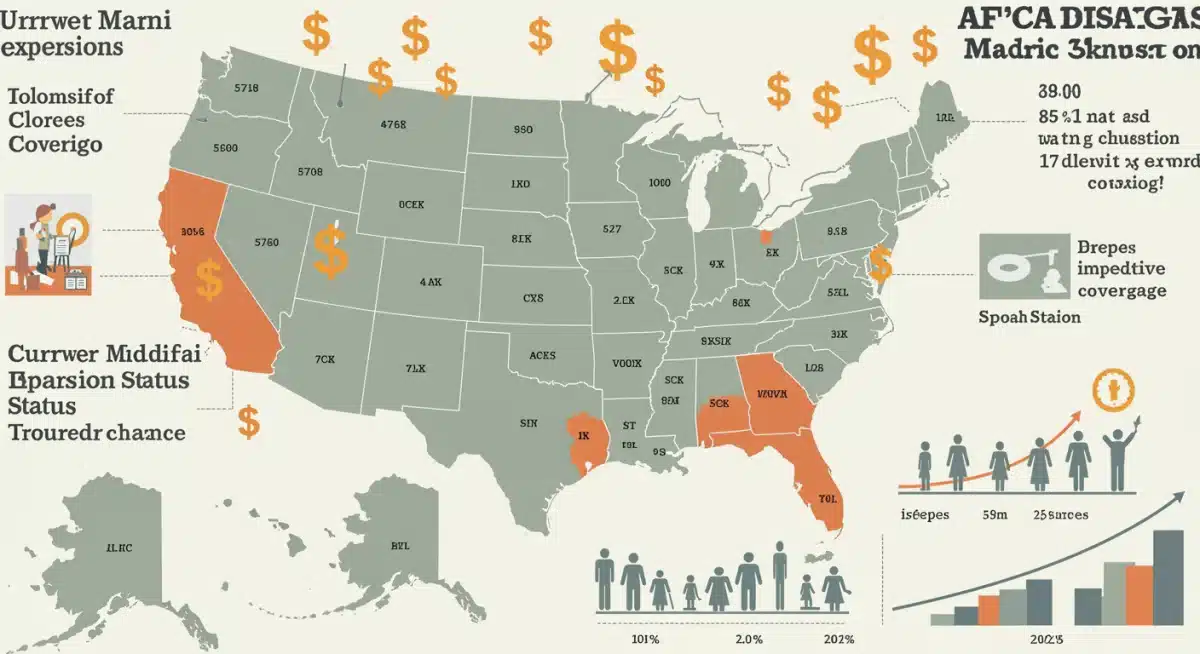2025 Medicaid Expansion: Financial Impact for Millions

The 2025 Medicaid Expansion Policies are poised to significantly alter healthcare access and affordability, directly impacting the financial stability and health coverage of over 5 million Americans nationwide.
Breaking news in healthcare policy confirms that the Understanding the 2025 Medicaid Expansion Policies: Financial Implications for Over 5 Million Americans will introduce substantial changes, directly affecting millions. This is not just a legislative update; it’s a critical development that could redefine health coverage for vulnerable populations, prompting immediate attention from individuals, families, and state governments alike. What do these changes mean for you and your community?
Key Changes Defined in the 2025 Medicaid Expansion
The landscape of healthcare coverage is on the cusp of a significant transformation as details emerge regarding the 2025 Medicaid Expansion Policies. These impending changes are not merely administrative adjustments; they represent a fundamental shift in how millions of Americans will access essential medical services. Understanding these core modifications is crucial for states, healthcare providers, and the individuals whose lives will be directly impacted.
At the heart of the 2025 expansion are revised eligibility criteria and new federal funding mechanisms designed to incentivize broader state participation. These structural alterations aim to reduce the number of uninsured individuals, particularly in states that have historically resisted expansion under the Affordable Care Act (ACA). The focus is on bridging coverage gaps and ensuring that more low-income adults can access necessary medical care without facing insurmountable financial barriers.
Revised Eligibility Thresholds
A primary component of the 2025 policies involves updated income thresholds for Medicaid eligibility. These revisions are projected to bring more individuals into the coverage fold, specifically those earning just above the previous federal poverty level guidelines but still struggling to afford private insurance. The intent is to capture a broader segment of the working poor and those in transitional employment situations.
- Expanded Income Limits: New guidelines are expected to push income eligibility higher, allowing more individuals and families to qualify.
- Streamlined Application Processes: Efforts are underway to simplify enrollment, making it easier for eligible individuals to sign up.
- Focus on Uninsured Adults: A particular emphasis is placed on extending coverage to adults without dependent children, a group often left out of traditional Medicaid programs.
Federal Funding Incentives
To encourage wider adoption of the expansion, the federal government is introducing enhanced financial incentives for states. This includes potentially higher federal matching rates for newly eligible populations, aiming to alleviate concerns about state budget burdens. These incentives are critical in swaying reluctant states towards expansion, highlighting the federal commitment to universal access.
Financial Implications for Over 5 Million Americans
The most immediate and profound impact of the 2025 Medicaid Expansion Policies will be felt by an estimated over 5 million Americans who stand to gain health coverage. This expansion promises not only access to medical care but also significant financial relief for households currently grappling with medical debt or foregoing necessary treatment due to cost. The financial implications extend beyond individual savings, influencing state economies and the healthcare industry as a whole.
For individuals, gaining Medicaid coverage means eliminating or substantially reducing out-of-pocket healthcare costs, including doctor visits, prescription drugs, emergency services, and preventive care. This shift can free up household income for other essential needs, improving overall financial stability. Moreover, it can prevent catastrophic medical bills from plunging families into poverty, a common outcome for the uninsured facing serious health issues.
Reduced Out-of-Pocket Expenses
With Medicaid coverage, beneficiaries typically face minimal to no premiums, deductibles, or co-payments. This financial protection is a game-changer for low-income individuals who often delay or skip medical care simply because they cannot afford the upfront costs associated with even minor health issues. The resulting early detection and management of chronic conditions can lead to better health outcomes and a reduced need for expensive emergency interventions.
- Lower Healthcare Costs: Direct savings on doctor visits, prescriptions, and hospital stays.
- Protection Against Medical Debt: Significant reduction in the risk of accumulating overwhelming medical bills.
- Access to Preventive Care: Encouragement of regular check-ups and screenings, improving long-term health.

State-Level Impact and Budgetary Considerations
The 2025 Medicaid Expansion Policies will necessitate significant adjustments at the state level, particularly concerning budgetary allocations and healthcare infrastructure. While federal funding aims to offset a substantial portion of the costs, states must still prepare for increased enrollment, administrative demands, and potential shifts in their healthcare markets. The decision to expand or not continues to be a critical debate in several states, with these new policies potentially tipping the scales.
States that have already expanded Medicaid have generally seen economic benefits, including job creation in the healthcare sector and reduced uncompensated care costs for hospitals. For non-expansion states, the 2025 policies present a renewed opportunity to capture federal dollars and improve the health of their low-income populations. However, concerns about long-term state financial responsibility and the capacity of existing healthcare systems to handle increased demand remain central to the discussion.
Economic Benefits and Challenges
Expanding Medicaid often leads to a healthier workforce, which can boost productivity and economic growth. States also benefit from the influx of federal funds, which stimulate local economies. However, managing the administrative burden of increased enrollment, ensuring adequate provider networks, and budgeting for the state’s share of costs present ongoing challenges. These policies require careful planning and resource allocation to be successful.
Eligibility Criteria and Enrollment Process for 2025
Navigating the eligibility criteria and enrollment process for the 2025 Medicaid Expansion Policies is paramount for individuals seeking coverage. While the overarching goal is to simplify access, understanding the specific requirements and steps involved will be crucial for successful enrollment. These policies are designed to reach a broader demographic, moving beyond traditional categories to include more working adults without children.
Generally, eligibility will continue to be based on a percentage of the Federal Poverty Level (FPL), with the expansion targeting those earning up to 138% of the FPL. However, states have some flexibility in implementing these guidelines. Prospective applicants should monitor their state’s specific announcements regarding income thresholds and asset limits as 2025 approaches. The emphasis is on making the process as straightforward as possible to maximize enrollment among eligible populations.
Navigating the Application Steps
The enrollment process typically involves submitting an application through state Medicaid agencies or the Health Insurance Marketplace. Applicants will need to provide documentation verifying income, household size, and residency. Many states offer online portals, telephone assistance, and in-person support to help individuals complete their applications. Early preparation and gathering necessary documents can expedite the process.
- Online Portals: Most states provide online applications for convenience and speed.
- Required Documentation: Proof of income, residency, and household composition are essential.
- Assistance Programs: Navigators and trained staff are available to help with complex cases and questions.
Impact on Healthcare Providers and Systems
The 2025 Medicaid Expansion Policies will have a ripple effect across the entire healthcare ecosystem, fundamentally altering how providers operate and how health systems manage patient loads. With millions more Americans gaining coverage, hospitals, clinics, and individual practitioners will experience both opportunities and challenges. The changes are expected to alleviate some financial pressures on providers while also increasing demand for services.
Hospitals, in particular, stand to benefit from a reduction in uncompensated care, as more patients will have insurance to cover their treatments. This can significantly improve hospital finances, allowing for reinvestment in facilities, technology, and staff. However, the surge in newly insured patients will also test the capacity of existing healthcare infrastructure, potentially leading to longer wait times and a need for expanded services, especially in rural or underserved areas.
Addressing Provider Capacity
To meet the anticipated increase in demand, healthcare systems will need to strategize on expanding their workforce, including physicians, nurses, and support staff. Telehealth services may also play a crucial role in bridging access gaps, particularly for routine appointments and mental health services. Furthermore, states may need to implement initiatives to encourage more providers to accept Medicaid patients, ensuring adequate access across all regions.
The shift from uninsured to insured patients also means a change in billing and administrative procedures. While this can streamline payments for providers, it also requires adapting to Medicaid’s specific reimbursement rates and administrative requirements. Training and updated systems will be essential to manage this transition smoothly, ensuring that the benefits of expanded coverage are fully realized by both patients and providers.
Public Health Outcomes and Long-Term Projections
Beyond the immediate financial and systemic impacts, the 2025 Medicaid Expansion Policies are anticipated to yield significant public health outcomes and shape long-term health trends across the nation. By extending coverage to millions, these policies are poised to improve access to preventive care, chronic disease management, and mental health services, leading to a healthier overall population. The long-term projections suggest a reduction in health disparities and an increase in life expectancy in expanded states.
Increased access to health insurance is strongly correlated with better health status, fewer preventable hospitalizations, and earlier diagnosis of serious conditions. This means a more proactive approach to health rather than reactive emergency care. For communities, this translates into a stronger, more resilient population, capable of contributing more effectively to the economy and society. The focus on preventive care, in particular, is expected to yield substantial benefits over time, reducing the incidence and severity of various illnesses.
Reducing Health Disparities
One of the core objectives of Medicaid expansion is to reduce existing health disparities among different demographic groups. Low-income communities and minority populations often face greater barriers to healthcare access, leading to worse health outcomes. By providing comprehensive coverage, the 2025 policies aim to level the playing field, ensuring that everyone has the opportunity to receive quality medical care regardless of their socioeconomic status.
- Improved Access to Care: More regular doctor visits and screenings lead to better health.
- Enhanced Chronic Disease Management: Consistent care for conditions like diabetes and heart disease.
- Mental Health Support: Greater access to counseling and psychiatric services, addressing a critical public health need.
| Key Aspect | Brief Description |
|---|---|
| Target Population | Over 5 million low-income Americans projected to gain coverage. |
| Financial Impact | Reduced out-of-pocket costs, less medical debt for beneficiaries. |
| State Involvement | New federal incentives for states to expand, impacting budgets and healthcare systems. |
| Healthcare Providers | Increased patient load, reduced uncompensated care, potential for infrastructure strain. |
Frequently Asked Questions About 2025 Medicaid Expansion
The 2025 Medicaid Expansion Policies are primarily designed to benefit low-income adults, particularly those without dependent children, who currently fall into a coverage gap. An estimated over 5 million Americans are projected to gain access to essential health coverage, significantly improving their financial and health stability.
For individuals, the expansion means significantly reduced out-of-pocket healthcare costs, including minimal or no premiums, deductibles, or co-payments. This financial relief can prevent medical debt, allow for earlier access to preventive care, and free up household income for other necessities, improving overall economic security.
States will face revised eligibility criteria and new federal funding incentives aimed at encouraging broader participation. While this can lead to economic benefits and reduced uncompensated care, states must also prepare for increased administrative demands, potential strain on healthcare infrastructure, and careful budgetary planning.
Eligibility will generally be based on a percentage of the Federal Poverty Level, often up to 138% FPL. Individuals should monitor their state’s specific announcements regarding income thresholds and asset limits. Applications can typically be submitted through state Medicaid agencies or the Health Insurance Marketplace, often with online and in-person assistance available.
Long-term benefits include improved access to preventive care, better management of chronic diseases, and increased mental health support. This is projected to lead to a healthier overall population, reduced health disparities among different demographic groups, fewer preventable hospitalizations, and potentially an increase in life expectancy in expanding states.
Looking Ahead: The Evolving Landscape of Healthcare Access
The implementation of the 2025 Medicaid Expansion Policies marks a pivotal moment in American healthcare. As these changes unfold, the focus will shift to monitoring their real-world impact on individuals, state budgets, and healthcare systems. Stakeholders will be closely watching enrollment numbers, healthcare access metrics, and the financial stability of providers. Further legislative discussions and potential adjustments to federal funding are anticipated as states adapt to the new framework. This evolving landscape underscores a continuing national effort to ensure broader access to affordable healthcare, with significant implications for public health and economic well-being across the country.





